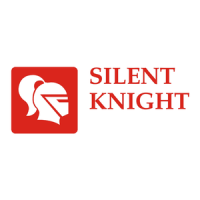150965 5-1
Section 5
S
stem Operation
5.1 Partitions and Areas
Software partitions and areas are optional features that allow you to configure the system for a
high degree of flexibility.
The 4821/4820 can be sub-divided into multiple partitions, each of which can operate as inde-
pendent systems. Each 4821/4820 system can have as many as 8 partitions, and each can
report to the central station as separate accounts. Touchpads and zones can be assigned to only
one partition.
Note: If you are installing a UL listed application, see Section 1.4.3 for UL requirements regarding partitions.
End-users and the central station may use their partition without being aware that other parti-
tions exist (see). Partitioned systems do, however, share the following system resources:
Telephone lines Telephone lines and programmable options that affect general
operation of telephones.
Sirens (or bells) By default, sirens (or bells) are global features of the 4821/
4820. This means that a siren occurring in one partition would
output in all partitions. Siren/bell output can be controlled
individually through use of the optional 4880N-750-SDB Sta-
tus OutputDisplay Module and programmable I/O. See the
4880N-750-SDB Installation Manual, P/N 150912TD1082
for more information.
General system operation Other operational features that affect the general operation of
the system, such as system power-up mode, are considered
system-level.
These options are described in greater detail in Section 6.3.1.1.
For controlling access within a system, partitions can be further sub-divided into as many as 8
areas. End-users may be aware that other areas exist within the partition, but they may not
have access to those areas. While partitions report as separate accounts to the central station;
areas do not. Areas, however, can share touchpads and zones.
Figure 5-1 (next page) illustrates the concept of partitions and areas.

